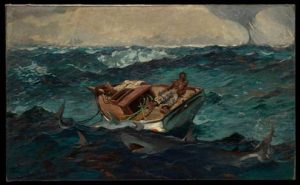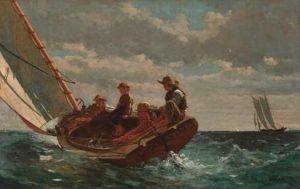When it comes to the artist Winslow Homer, many of us are familiar with his iconic paintings. Some of us are even familiar with his brilliant techniques. What is lesser known, however, is how he signs his famous paintings; how he lets, you know the authenticity of his works.
In this article, you’ll learn about Winslow Homer and how he typically signs his paintings. We provide you with tips on how to spot authentic and fake prints and also provide some excellent examples to show you just what to look for.
Winslow Homer Artist Signature Style
Winslow Homer is an American painter renowned for his landscapes and seascapes. Many greatly admired his work for its simplistic yet emotionally powerful style. Homer used various media to create his works, including oil paints, watercolors, etchings, lithographs, and engravings.
He also used unique techniques to sign his works to distinguish them from other artists’ paintings. He would often sign his works with a single initial or two initials (“WH”) placed in the lower left corner of the painting. For example, Winslow Homer’s watercolor paintings were also signed with “Homer” or “Winslow Homer” printed in the lower right corner.
Winslow Homer prints are highly sought after by collectors and art enthusiasts alike. His authentic artworks have stood the test of time and are celebrated as some of the greatest in American art history. His artwork is a perfect example of how the power of visual expression can convey complex emotions and captivate viewers.
Whether you are a collector or simply enjoy admiring the beauty of his art, authentic Winslow Homer prints will bring joy and meaning to any home or office.
Where to Find Winslow Homer Paintings
Winslow Homer’s works have been exhibited in museums across the world, including the Metropolitan Museum of Art, the National Gallery of Art, and the Museum of Fine Arts in Boston. Unfortunately, while many of his original paintings can be found in these prestigious institutions, they are not always readily available to the public.
Fortunately, there are other ways to find works by Winslow Homer. One option is to search for Winslow Homer prints. Prints are copies of the original painting made using various printing techniques, such as lithography or wood engraving. These reproductions may be more affordable than an original painting and can still be treasured by art enthusiasts. Prints of Winslow Homer’s work can be found at a variety of art galleries, online sites, and specialty stores.
When searching for Winslow Homer prints, it is important to ensure you get an authentic reproduction. First, check the website you’re buying from to ensure it is reputable and offers authenticated prints. Many companies provide certificates of authenticity for their products, so check for this when making your purchase. Additionally, look for details in the print that match the original painting.
How to Spot a Fake Winslow Homer Painting
When it comes to art, forgeries can be hard to spot. This is particularly true when it comes to famous painters like Winslow Homer. With that into consideration, here are some tips to help you detect a fake Winslow Homer painting or print.
- Look for the signature: If the painting is original, it will have a signature on the lower right side, usually just below the subject of the painting. It may also be written along the bottom edge of the painting. The signature should be composed of neat cursive letters with a small “h” that is slightly curved. The forger may attempt to replicate this signature, but it will likely appear sloppy, and the “h” may be too curved or large.
- Check the quality of the paint: A real Winslow Homer painting will have a strong color saturation, while a fake may appear washed out or over-saturated. Additionally, Winslow Homer’s brushstrokes were typically thick and confident – so a forgery will often appear rushed or thin.
- Check the use of light and shadows in the paintings: A fake may appear flat and void of shadows, while an original will have a more three-dimensional quality with deep shadows and highlights.
These simple steps allow you to easily identify a genuine Winslow Homer painting or print from a fake one. However, don’t be afraid to ask an expert for help if you have any doubts, as it is important to ensure you are investing your money in the real deal. Here is a list of Winslow Homer prints with some of his signature styles:
Examples of Winslow Homer Signatures on Famous Winslow Homer Artworks
The Gulf Stream (1899)

Metropolitan Museum of Arts, New York
This oil painting is a fantastic example of Homer’s use of lithography to portray the drama of the sea. Although hard to see, Winslow Homer’s signature here appears on the bottom left corner of the painting.
Snap The Whip (1872)

Metropolitan Museum of Arts, New York
The vibrant blue sky in this painting, one of Homer’s trademarks, is made even more dramatic by using lithography to add depth and texture. In addition, you can see his signature, which is different here and only consists of the slanted word “Homer” at the bottom right corner.
Breezing Up (A Fair Wind), 1873

National Gallery of Art, Washington DC
This painting shows four men in a boat, with a large sail billowing in the wind. Homer’s signature appears in the bottom right corner of the painting and also constitutes the slanted word “Homer.”
Conclusion
The signature of Winslow Homer on his paintings plays an integral role in their value and authenticity. All prints can be distinguished from originals by the presence or absence of Homer’s signature.
In addition to signatures, you should also check the art style used to create the painting. When doing this, you most especially check for the lithography technique, which is common with Winslow Homer prints. By checking prints, you ensure that you are getting or looking at a genuine Winslow Homer print.

